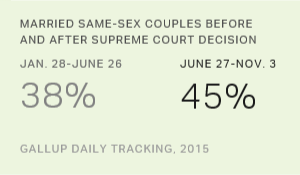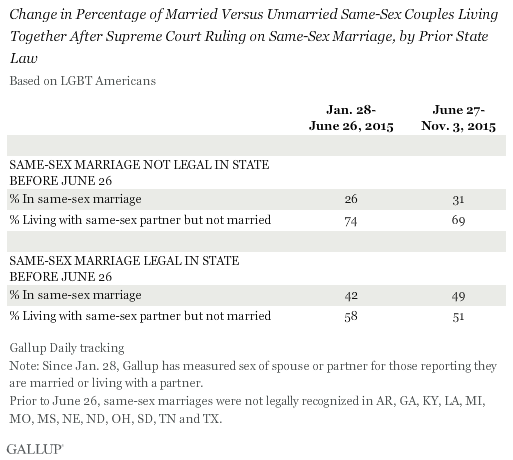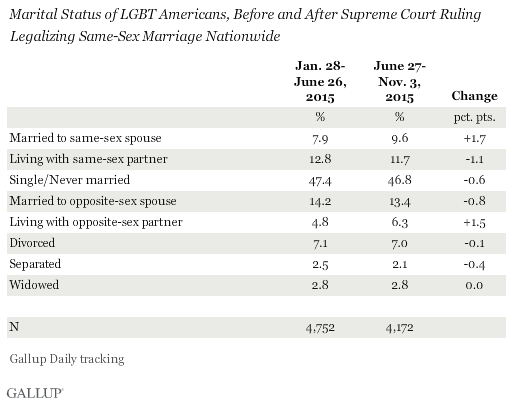Story Highlights
- Share of married same-sex cohabiting couples up from 38% to 45%
- Increases in both states where it had previously been legal or illegal
PRINCETON, N.J. -- More lesbian, gay, bisexual or transgender Americans living with a same-sex partner now report being married (45%) than did so prior to the U.S. Supreme Court's June 26 decision to make same-sex marriages legal in all 50 states (38%).

The results are based on Gallup Daily tracking interviews conducted in 2015, including interviews with 4,752 LGBT Americans through June 26, the day the Supreme Court issued its ruling, and 4,172 LGBT Americans since then.
The decision in Obergefell v. Hodges and three related cases made same-sex marriage legal nationwide and will dramatically expand and protect the rights of same-sex couples for generations to come. But its immediate and direct impact is mostly limited to same-sex couples in committed relationships.
Gallup's data do not distinguish whether those who identify as LGBT primarily think of themselves as lesbian, gay, bisexual or transgender. This is important because many bisexuals in particular are married or living with opposite-sex partners while most lesbians and gay men marry or live with same-sex partners.
But Gallup does ask those who identify as LGBT, and also report being married or living with a partner, whether their spouse or partner is the same sex as them. Isolating the increase in married versus unmarried LGBT Americans living with a same-sex partner provides the most direct evidence of how same-sex marriages have increased significantly following the Obergefell decision.

Same-Sex Marriage Rates Up in States Where It Was Already Legal
The practical legal impact of the Obergefell decision was to invalidate laws in 13 states that did not recognize same-sex marriages. Since then, the percentage of same-sex married couples increased from 26% to 31% in those states. Prior to Obergefell, states that did not recognize or conduct marriages of same-sex couples still had same-sex married couples residing there. But those couples either married elsewhere or considered themselves married even if the state did not. Those spouses' rights were enhanced by the Supreme Court's 2013 ruling in U.S. v. Windsor that ensured the federal government would recognize marriages of same-sex couples even in states where such marriages were not recognized by the state.
But states whose laws were not affected by the Obergefell ruling have also seen a notable increase in same-sex marriages over the last four months. Currently, 49% of same-sex couples living together in states where same-sex marriages were already legal report being married, compared with 42% prior to the decision. That means same-sex couples living together in these states are now as likely to be married as not married.

Estimated Increase of 96,000 Same-Sex Married Couples
Overall, 3.9% of all Americans identify as LGBT, and 0.4% of all Americans are in a same-sex marriage. The latter figure is up from 0.3% before the ruling.
Those figures can be used to estimate that there are now approximately 972,000 Americans in a same-sex marriage, up from approximately 780,000 before the ruling. Put differently, there are now approximately 486,000 same-sex marriages in the U.S., compared with approximately 390,000 four months ago.
Nearly One in 10 LGBT Now Married to Same-Sex Partner
Among all LGBT Americans, 9.6% currently describe themselves as being married to a same-sex spouse, up from 7.9% before the Supreme Court's decision. There has been a decline in the percentage of LGBT Americans who say they are not married but are living with someone of the same sex, from 12.8% to 11.7%. Nearly half of LGBT Americans, 46.8%, identify as single, likely because LGBT as a group tend to be younger, on average.

Since June, the percentage of LGBT Americans in opposite-sex marriages has decreased from 14.2% to 13.4%. However, it is still the case that more LGBT individuals report being in opposite-sex marriages than in same-sex marriages. This is likely due to the high proportion of bisexuals within the LGBT population. Other surveys show that bisexuals account for roughly half of the LGBT population, and that the vast majority of bisexuals who report having a spouse or living with a partner are in an opposite-sex relationship.
The decrease in the percentage of LGBT individuals in opposite-sex marriages and the increase in opposite-sex domestic partnerships since June likely reflects changing patterns in the relationship status of bisexual Americans since relatively few gay men or lesbians report having an opposite-sex spouse or partner.
Implications
Just four months after the landmark Obergefell decision, there has already been a notable shift toward marriage and away from living together among same-sex couples in the U.S. who live under the same roof. If those trends continue, marriage will soon overtake domestic partnerships as the more common relationship status among committed same-sex couples. In the states where same-sex marriage was legal prior to the Supreme Court decision, same-sex couples are already as likely to be married as they are to be living together.
The Supreme Court's ruling was controversial in many respects but is also reflective of public opinion on the issue. Americans' support for same-sex marriage has grown rapidly in the past decade, particularly in states where same-sex couples could legally marry. And support for same-sex marriage may not have peaked as more Americans will encounter married same-sex couples routinely in their lives, and younger generations in this country show much greater support for same-sex marriage than do older generations.
Gary J. Gates is Blachford-Cooper Distinguished Scholar and Research Director at the Williams Institute, UCLA School of Law. A national expert in LGBT demographics, he has a Ph.D. in public policy from Heinz College, Carnegie Mellon University.
These data are available in Gallup Analytics.
Survey Methods
Results for this Gallup poll are based on telephone interviews with a random sample of adults, aged 18 and older, living in all 50 U.S. states and the District of Columbia, on the Gallup U.S. Daily survey. Sample sizes and margins of error are shown in the accompanying table:

All reported margins of sampling error include computed design effects for weighting.
Each sample of national adults includes a minimum quota of 50% cellphone respondents and 50% landline respondents, with additional minimum quotas by time zone within region. Landline and cellular telephone numbers are selected using random-digit-dial methods.
Learn more about how Gallup Daily tracking works.
